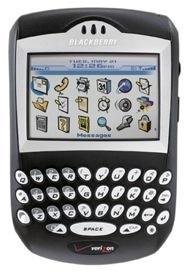Though the avid PhoneDog readers are well aware of my preference for BlackBerry devices, few people outside of my Twitter followers knew that I spent last month with the iPhone in an attempt to convince myself that other formidable smartphone options existed outside of the BlackBerry. My RIM loyalty goes back many years, through many different models. As a result, my thought process was that I may have gotten too comfortable with the BlackBerry product to render an effective judgment on another device.
Research In Motion's popular devices have been an integral part of my wireless life since 2005, having been introduced to the BlackBerry world by the 7250. The device was large and relatively boring, but I was fascinated by the idea of receiving push e-mail; something that wasn't popularized in 2005 as it is today. From then until now, I can proudly say that I have carried 29 BlackBerry's, though my numbers may be a bit of a fallacy, as I'm including several models that I have carried more than once. BlackBerry became a niche for me; with each new model and operating system build came new features that I "had to have." As if it was yesterday, I remember when the BlackBerry Pearl 8100 came out. Marketed as the "first consumer BlackBerry," it offered a camera and was billed as the thinnest BlackBerry to date. I bought it the day it launched.
One of my favorite things to do is to look back on wireless technology and think about the technological progression that we as a culture have experienced in such a short time period. Today, we have the BlackBerry Bold, a device with a 624 MHz processor and a gorgeous screen. The 8900, with it's compact form factor and equally stunning display. The Storm; which, even with its issues, pushed RIM into the touchscreen market with the SurePress screen. The Pearl Flip series, opening the door into the flip phone market. The purpose of a cell phone has evolved dramatically over the course of just a few years, and RIM has done an absolutely fantastic job of shifting with the marketplace. They quickly realized the untapped potential of the consumer market, and branched from their business roots to compete in a new field. And, more importantly, they were incredibly successful.
The 2007 launch of the original Apple iPhone changed the wireless industry as we knew it. Gone were the days of using cellular devices as secondary methods of communication; landlines were quickly moving into extinction. My fascination with the iPhone began in the fall of 2007, shortly after the launch and after the initial hype subsided. I was at dinner with a close friend who had purchased one at launch, and after spending time with his device, I was impressed. More specifically, I was amazed by the fluidity of the operating system. With a simple flick, the screen moved as if I was actually moving something with my hand. To this day, I have never seen another touchscreen device emulate the fluidity of the Apple iPhone. When July 11, 2008 rolled around, I was in line to purchase the iPhone 3G to review for a company I was writing for at the time. I spent just over two weeks with the device, and was blown away at the ease of use. Everything just worked. No system crashes or lockups.
So, this time around, I was determined to give the iPhone 3G a fair test as my personal device. If I liked it, I would ditch the BlackBerry and keep it; if not, I would return to my favorite BlackBerry, the Bold. The first few days, like anything new after familiarity with something else, were challenging. I kept attempting BlackBerry shortcuts to no success. But after a few days, I became accustomed to the on-screen gestures again, and was navigating with ease. I have to give credit to Apple; the seamless integration of iTunes and the App Store is what puts the iPhone ahead of other phones as a media-centric device. The ability to quickly download a song or application that I wanted while on the road or in a hotel is a contributing factor to the astounding success of the device.
The iPhone fulfills something that no other phone or company does as effectively as of yet, and that is the offering of a truly functional App Store. As smartphones become more expensive and the recession continues to linger, individuals will be much more content purchasing a $2.99 application that adds a needed feature to their phone, versus purchasing another model that offers the same ability. And for those that haven't had the pleasure of experiencing Apple's App Store, believe me when I say that there is an application for almost everything. When I wanted to check the weather beyond the stock application that comes with the device, I downloaded an application. When I wanted to view my bank balances, I downloaded an application. Bills were regularly checked and paid on the device. It offered the ability to do almost everything from the palm of my hand, significantly reducing my time on the computer at home.
In the end, I did return to the BlackBerry, primarily for e-mail purposes. For work, I send and receive so many e-mails per day that I found the BlackBerry to be a more effective medium for e-mail delivery. The iPhone only allows one exchange account, whereas I have three that I actively use on a daily basis. Don't get me wrong; I miss the iTunes capability, as well as the App Store, on a regular basis. But I need the 'business' e-mail support, which is something that Apple doesn't provide as of yet. Would I recommend the iPhone? Absolutely. In the media-centric market, it's second to none. But for me, a BlackBerry user I was, a BlackBerry addict I am, and a BlackBerry fanatic I will be.